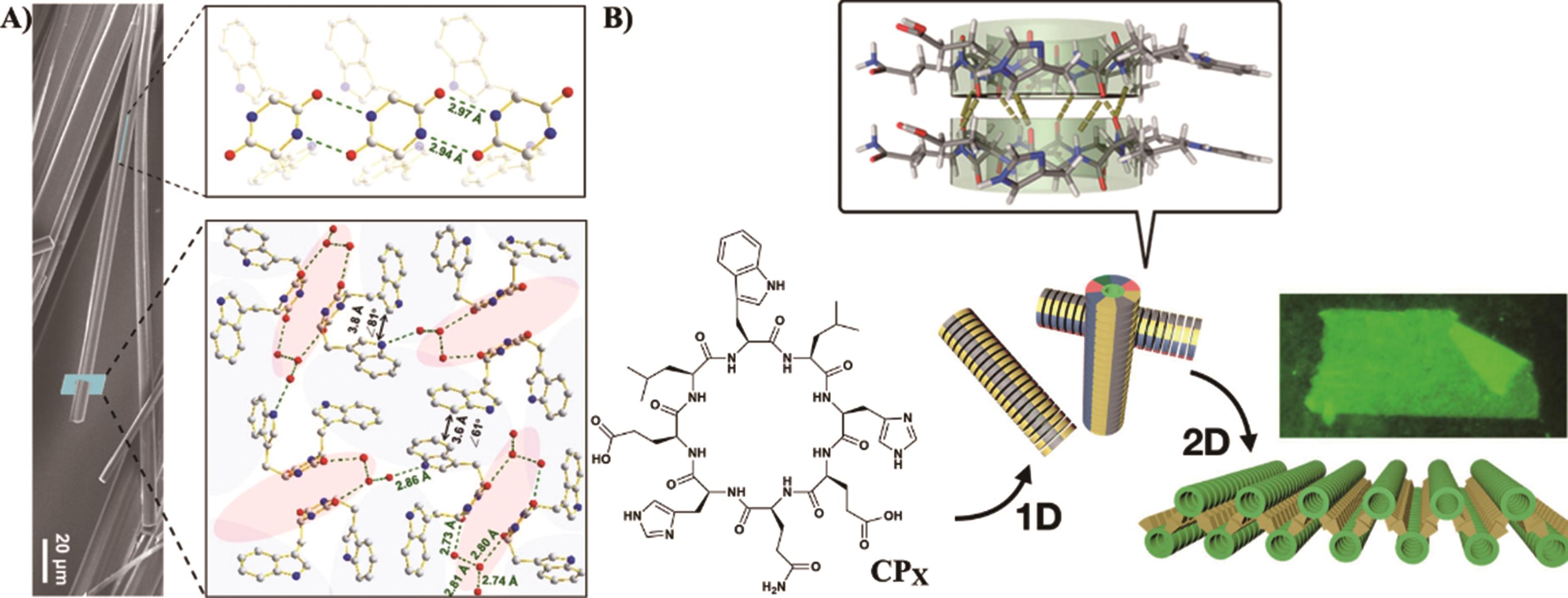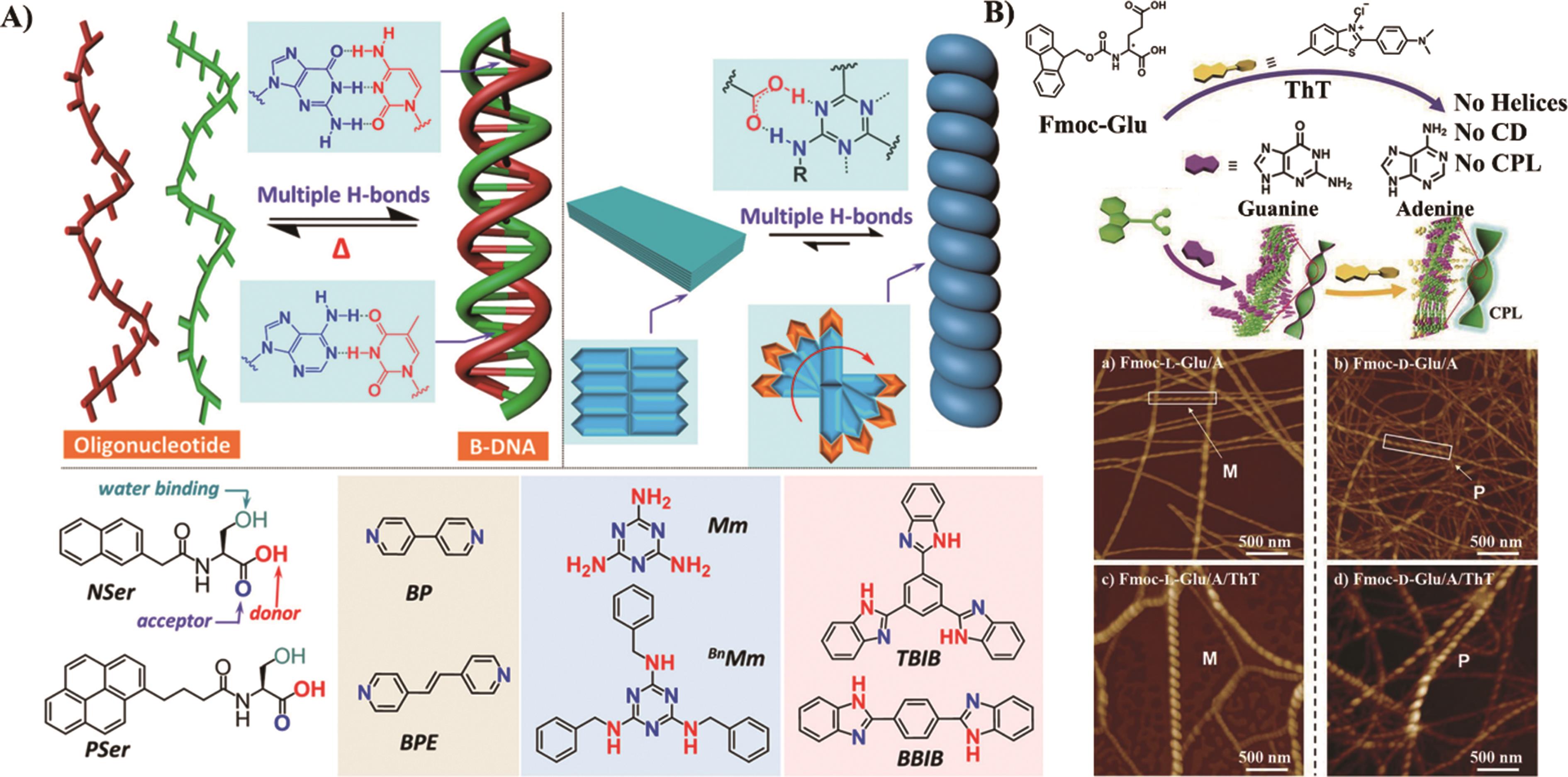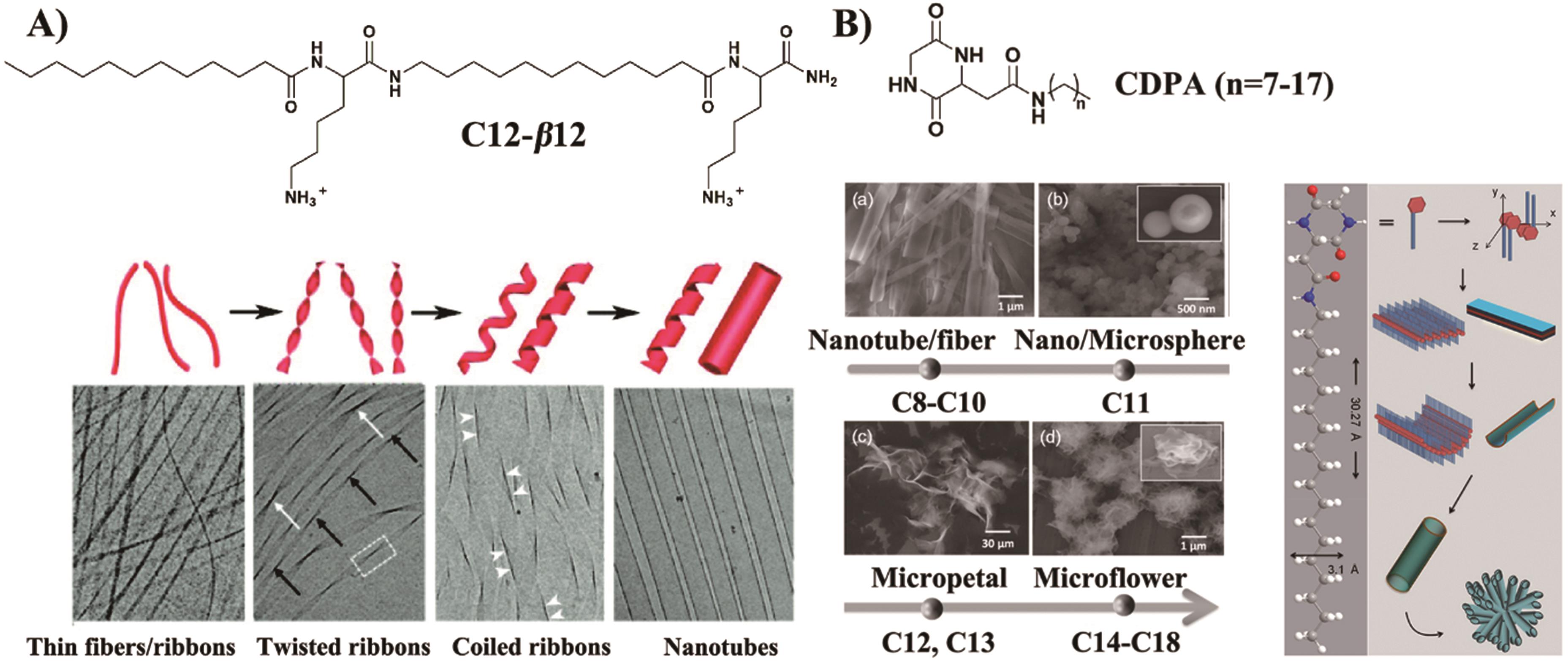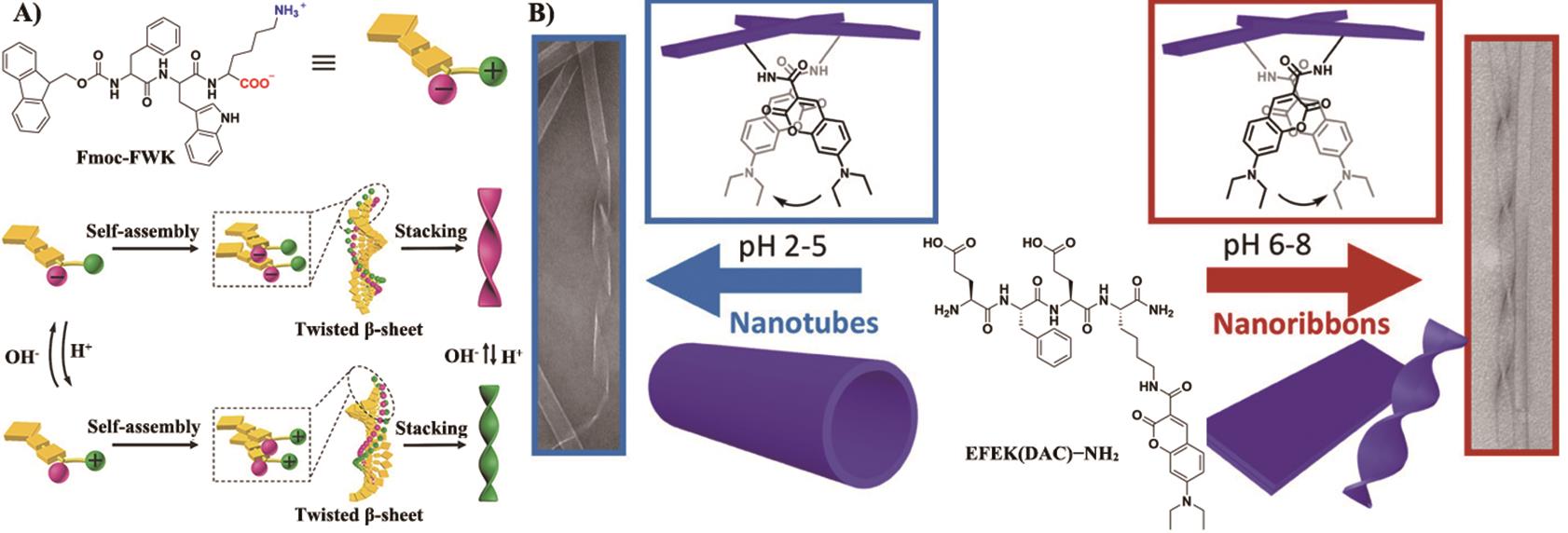
应用化学 ›› 2022, Vol. 39 ›› Issue (8): 1190-1201.DOI: 10.19894/j.issn.1000-0518.210507
短肽超分子自组装驱动力及调控策略的研究发展
- 中国石油大学(华东)化学工程学院生物工程与技术中心,青岛 266580
-
收稿日期:2021-10-24接受日期:2022-04-21出版日期:2022-08-01发布日期:2022-08-04 -
通讯作者:王继乾,徐海 -
基金资助:国家自然科学基金项目(22072181)
Research Progress of Regulation of Driving Forces in Short Peptide Supramolecular Self‑Assembly
Wei-Qiang ZHANG, Chen WANG, Yu-Rong ZHAO, Dong WANG, Ji-Qian WANG( ), Hai XU(
), Hai XU( )
)
- Center for Bioengineering & Biotechnology,College of Chemical Engineering,China University of Petroleum (East China),Qingdao 266580,China
-
Received:2021-10-24Accepted:2022-04-21Published:2022-08-01Online:2022-08-04 -
Contact:Ji-Qian WANG,Hai XU -
About author:xuh@upc.edu.cn
jqwang@upc.edu.cn
-
Supported by:the National Natural Science Foundational of China(22072181)
摘要:
短肽分子在弱相互作用力驱动下可以自发形成形貌多样的自组装体。这些弱相互作用力包括静电作用、氢键作用和π-π堆积作用等,它们相互耦合,协同驱动短肽自组装过程。通过对短肽分子有目的性的序列设计和修饰,可以针对性调节自组装驱动力,从而实现对自组装体结构和形貌的有效调控,进而实现肽基超分子材料的可控制造与功能化。本文系统综述了氢键作用、π-π堆积作用、静电作用、疏水效应、金属离子配位和手性中心等因素对短肽自组装行为的影响规律,以及通过氨基酸序列设计与分子修饰、改变溶液pH值和短肽分子浓度、金属离子配位等因素对组装驱动力的调控机制。最后,对肽基超分子材料在生物医学、生物催化等领域的特定功能开发进行了展望。
中图分类号:
引用本文
张伟强, 王晨, 赵玉荣, 王栋, 王继乾, 徐海. 短肽超分子自组装驱动力及调控策略的研究发展[J]. 应用化学, 2022, 39(8): 1190-1201.
Wei-Qiang ZHANG, Chen WANG, Yu-Rong ZHAO, Dong WANG, Ji-Qian WANG, Hai XU. Research Progress of Regulation of Driving Forces in Short Peptide Supramolecular Self‑Assembly[J]. Chinese Journal of Applied Chemistry, 2022, 39(8): 1190-1201.

图1 (A) c-WW晶体与晶体结构示意图[23]; (B) 环状肽CPx从1D到2D的自组装示意图[25]
Fig.1 (A) c-WW crystals and the crystal structure[23]; (B) The sequential 1D-to-2D self-assembly of cyclic peptide CPx[25]

图3 (A) Nser/Pser和三聚氰胺等分子的结构以及基于氢键作用诱导的芳香基团手性堆积的示意图[43]; (B) Fmoc-Glu和嘌呤、ThT共组装机理以及组装体形貌图[44]
Fig.3 (A) The schematic illustration of aromatic groups chiral stacking by hydrogen bonds and the molecular structure of Nser/Pser, melamine[43]; (B) The co-assembly mechanism and morphology of Fmoc-Glu, Purines (G/A) and ThT[44]

图4 (A) C12-β12一维超分子结构的演化图像[47]; (B) CDPA微观组装体形貌以及C14-CDPA自组装机理图[48]
Fig.4 (A) The evolution images of the 1-D supramolecular structures of C12-β12[47]; (B) Morphological evolution of CDPA nano and microarchitectures and schematic diagram of C14-CDPA self-assembly mechanism[48]

图5 (A) 血红素与短肽构建人工酶催化环丙烷化反应示意图[85]; (B) 肽基人工酶的制备以及催化反应[87]
Fig.5 (A) Schematic representation of hemin association with catalytic amyloids to promote cyclopropanation[85]; (B) The preparation and catalytic reaction of a peptide-based artificial hydrolase[87]
| 1 | SONG W L, SONG P, SUN Y J, et al. Self-assembly of multifunctional DNA nanohydrogels with tumor microenvironment-responsive cascade reactions for cooperative cancer therapy[J]. ACS Biomater Sci Eng, 2021, 7(11): 5165-5174. |
| 2 | BISWAS S, DATTA L P, KUMAR DAS T. A bioinspired stimuli-responsive amino acid-based antibacterial drug delivery system in cancer therapy[J]. New J Chem, 2022, 46(15): 7024-7031. |
| 3 | FANG C, ZHAO Q Q, ZHAO F P, et al. All-vacuum deposited perovskite solar cells with glycine modified NiOx hole-transport layers[J]. RSC Adv, 2022, 12(18): 10863-10869. |
| 4 | SURíS-VALLS R, HOGERVORST T P, SCHOENMAKERS S M C, et al. Inhibition of ice recrystallization by nanotube-forming cyclic peptides[J]. Biomacromolecules, 2022, 23(2): 520-529. |
| 5 | WEERAKKODY J S, EL KAZZY M, JACQUIER E, et al. Surfactant-like peptide self-assembled into hybrid nanostructures for electronic nose applications[J]. ACS Nano, 2022, 16(3): 4444-4457. |
| 6 | CHEN T T, LYU Y F, TAN M S, et al. Fabrication of supramolecular antibacterial nanofibers with membrane-disruptive mechanism[J]. J Med Chem, 2021, 64(22): 16480-16496. |
| 7 | ENGELBERG Y, RAGONIS-BACHAR P, LANDAU M. Rare by natural selection: disulfide-bonded supramolecular antimicrobial peptides[J]. Biomacromolecules, 2022, 23(3): 926-936. |
| 8 | ABBAS M, SUSAPTO H H, HAUSER C A E. Synthesis and organization of gold-peptide nanoparticles for catalytic activities[J]. ACS Omega, 2022, 7(2): 2082-2090. |
| 9 | WU Y T, LI Q, CAO J J, et al. Pillararene-peptide nanogels and their biomimetic mineralization hybrids for heterogeneous catalysis[J]. ACS Appl Nano Mater, 2021, 4(10): 11126-11133. |
| 10 | GONG Z Y, ZHOU B L, LIU X Y, et al. Enzyme-induced transformable peptide nanocarriers with enhanced drug permeability and retention to improve tumor nanotherapy efficacy[J]. ACS Appl Mater Interfaces, 2021, 13(47): 55913-55927. |
| 11 | KULKARNI K, MINEHAN R L, GAMOT T, et al. Esterase-mediated sustained release of peptide-based therapeutics from a self-assembled injectable hydrogel[J]. ACS Appl Mater Interfaces, 2021, 13(49): 58279-58290. |
| 12 | LI B, CRIADO-GONZALEZ M, ADAM A, et al. Peptide hydrogels assembled from enzyme-adsorbed mesoporous silica nanostructures for thermoresponsive doxorubicin release[J]. ACS Appl Nano Mater, 2022, 5(1): 120-125. |
| 13 | MA Z Y, LIU X H, NIE J L, et al. Nano-antimicrobial peptides based on constitutional isomerism-dictated self-assembly[J]. Biomacromolecules, 2022, 23(3): 1302-1313. |
| 14 | DE MELLO L R, CARRASCOSA V, REBELATO E, et al. Nanostructure formation and cell spheroid morphogenesis of a peptide supramolecular hydrogel[J]. Langmuir, 2022, 38(11): 3434-3445. |
| 15 | WU B H, ZHAO S, YANG X J, et al. Biomimetic heterodimerization of tetrapeptides to generate liquid crystalline hydrogel in atwo-component system[J]. ACS Nano, 2022, 16(3): 4126-4138. |
| 16 | GUO K X, LIU W, WANG Y, et al. Handedness inversion of the self-assemblies of lipotetrapeptides regulated by the shift of the methyl group[J]. New J Chem, 2022, 46(15): 6971-6976. |
| 17 | MASON M L, LIN T, LINVILLE J J, et al. Co-assembly of a multicomponent network of nanofiber-wrapped nanotubes[J]. Nanoscale, 2022, 14(12): 4531-4537. |
| 18 | SIVAGNANAM S, DAS K, BASAK M, et al. Self-assembled dipeptide based fluorescent nanoparticles as a platform for developing cellular imaging probes and targeted drug delivery chaperones[J]. Nanoscale Adv, 2022, 4(6): 1694-1706. |
| 19 | DONG Q Q, WANG M Y, WANG A H, et al. Self-assembly of Fmoc-amino acids in capillary confined space forming a parallel ordered fiber network for application in vascularization[J]. Biomater Sci, 2022, 10(6): 1470-1475. |
| 20 | MACPHERSON D S, MCPHEE S A, ZEGLIS B M, et al. The impact of tyrosine iodination on the aggregation and cleavage kinetics of MMP-9-responsive peptide sequences[J]. ACS Biomater Sci Eng, 2022, 8(2): 579-587. |
| 21 | ZHAO Y R, DENG L, YANG W, et al. Tuning one-dimensional nanostructures of bola-like peptide amphiphiles by varying the hydrophilic amino acids[J]. Chem Eur J, 2016, 22(32): 11394-11404. |
| 22 | ZHENG C, LIN S W, CHEN Y L, et al. Bola-type Ala-Ala dipeptides: odd-even effect in molecular packing structures[J]. Langmuir, 2019, 35(35): 11406-11413. |
| 23 | TAO K, TANG Y M, RENCUS-LAZAR S, et al. Bioinspired supramolecular packing enables high thermo-sustainability[J]. Angew Chem Int Ed, 2020, 59(43): 19037-19041. |
| 24 | ZIGANSHIN M A, SAFIULLINA A S, GERASIMOV A V, et al. Thermally induced self-assembly and cyclization of L-Leucyl-L-Leucine in solid state[J]. J Phys Chem B, 2017, 121(36): 8603-8610. |
| 25 | INSUA I, MONTENEGRO J. 1D to 2D self assembly of cyclic peptides[J]. J Am Chem Soc, 2020, 142(1): 300-307. |
| 26 | DRAPER E R, DIETRICH B, MCAULAY K, et al. Using small-angle scattering and contrast matching to understand molecular packing in low molecular weight gels[J]. Matter, 2020, 2(3): 764-778. |
| 27 | WYCHOWANIEC J K, PATEL R, LEACH J, et al. Aromatic stacking facilitated self-assembly of ultrashort ionic complementary peptide sequence: β-sheet nanofibers with remarkable gelation and interfacial properties[J]. Biomacromolecules, 2020, 21(7): 2670-2680. |
| 28 | MéNARD-MOYON C, VENKATESH V, KRISHNA K V, et al. Self-assembly of tyrosine into controlled supramolecular nanostructures[J]. Chem Eur J, 2015, 21(33): 11681-11686. |
| 29 | BERA S, XUE B, REHAK P, et al. Self-assembly of aromatic amino acid enantiomers into supramolecular materials of high rigidity[J]. ACS Nano, 2020, 14(2): 1694-1706. |
| 30 | ZHANG J K, LIU S N, LI H, et al. Tryptophan-based self-assembling peptides with bacterial flocculation and antimicrobial properties[J]. Langmuir, 2020, 36(38): 11316-11323. |
| 31 | HOSOKAWA T, TAKAHASHI Y, MATSUSHIMA T, et al. Synthesis, structures, and properties of hexapole helicenes: assembling six [5]helicene substructures into highly twisted aromatic systems[J]. J Am Chem Soc, 2017, 139(51): 18512-18521. |
| 32 | SCHUSTER N J, SÁNCHEZ R H, BUKHARINA D, et al. A helicene nanoribbon with greatly amplified chirality[J]. J Am Chem Soc, 2018, 140(20): 6235-6239. |
| 33 | NAKAKUKI Y, HIROSE T, MATSUDA K. Synthesis of a helical analogue of kekulene: a flexible π-expanded helicene with large helical diameter acting as a soft molecular spring[J]. J Am Chem Soc, 2018, 140(45): 15461-15469. |
| 34 | XING Q G, ZHANG J X, XIE Y Y, et al. Aromatic motifs dictate nanohelix handedness of tripeptides[J]. ACS Nano, 2018, 12(12): 12305-12314. |
| 35 | XIE Y Y, WANG Y F, QI W, et al. Reconfigurable chiral self-assembly of peptides through control of terminal charges[J]. Small, 2017, 13(30): 1700999. |
| 36 | MASON M L, LALISSE R F, FINNEGAN T J, et al. pH-controlled chiral packing and self-assembly of a coumarin tetrapeptide[J]. Langmuir, 2019, 35(38): 12460-12468. |
| 37 | BISWAS S, DAS A K. Tuning the handedness: role of chiral component in peptide-appended bolaamphiphile-based coassembled hydrogels[J]. Langmuir, 2019, 35(6): 2383-2391. |
| 38 | LIU Y Q, CHEN C F, WANG T Y, et al. Supramolecular chirality of the two-component supramolecular copolymer gels: who determines the handedness?[J]. Langmuir, 2016, 32(1): 322-328. |
| 39 | WU S S, YIN Z Z, WU D T, et al. Chiral enantioselective assemblies induced from achiral porphyrin by L- and D-lysine[J]. Langmuir, 2019, 35(51): 16761-16769. |
| 40 | XING P Y, LI P Z, CHEN H Z, et al. Understanding pathway complexity of organic micro/nanofiber growth in hydrogen-bonded coassembly of aromatic amino acids[J]. ACS Nano, 2017, 11(4): 4206-4216. |
| 41 | WU A L, GUO Y X, LI X B, et al. Co-assembled supramolecular gel of dipeptide and pyridine derivatives with controlled chirality[J]. Angew Chem Int Ed, 2021, 60(4): 2099-2103. |
| 42 | LIANG J C, HAO A Y, XING P Y, et al. Inverse evolution of helicity from the molecular to the macroscopic level based on N-terminal aromatic amino acids[J]. ACS Nano, 2021, 15(3): 5322-5332. |
| 43 | XING P Y, LI Y X, XUE S X, et al. Occurrence of chiral nanostructures induced by multiple hydrogen bonds[J]. J Am Chem Soc, 2019, 141(25): 9946-9954. |
| 44 | DENG M, ZHANG L, JIANG Y Q, et al. Role of achiral nucleobases in multicomponent chiral self-assembly: purine-triggered helix and chirality transfer[J]. Angew Chem Int Ed, 2016, 55(48): 15062-15066. |
| 45 | CUI H G, MURAOKA T, CHEETHAM A G, et al. Self-assembly of giant peptide nanobelts[J]. Nano Lett, 2009, 9(3): 945-951. |
| 46 | CUI H G, CHEETHAM A G, PASHUCK E T, et al. Amino acid sequence in constitutionally isomeric tetrapeptide amphiphiles dictates architecture of one-dimensional nanostructures[J]. J Am Chem Soc, 2014, 136(35): 12461-12468. |
| 47 | ZISERMAN L, LEE H Y, RAGHAVAN S R, et al. Unraveling the mechanism of nanotube formation by chiral self-assembly of amphiphiles[J]. J Am Chem Soc, 2011, 133(8): 2511-2517. |
| 48 | PANDURANGAN K, ROY B, RAJASEKHAR K, et al. Molecular architectonics of cyclic dipeptide amphiphiles and their application in drug delivery[J]. ACS Appl Bio Mater, 2020, 3(5): 3413-3422. |
| 49 | LEE N R, BOWERMAN C J, NILSSON B L. Effects of varied sequence pattern on the self-assembly of amphipathic peptides[J]. Biomacromolecules, 2013, 14(9): 3267-3277. |
| 50 | ZHAO Y R, WANG J Q, DENG L, et al. Tuning the self-assembly of short peptides via sequence variations[J]. Langmuir, 2013, 29(44): 13457-13464. |
| 51 | ZHAO Y R, DENG L, WANG J Q, et al. Solvent controlled structural transition of KI4K self-assemblies: from nanotubes to nanofibrils[J]. Langmuir, 2015, 31(47): 12975-12983. |
| 52 | WANG Y, ZHENG X J, LIU J, et al. Tumor-targeted anti-VEGF RNAi capable of sequentially responding to intracellular microenvironments for potent systemic tumor suppression[J]. ACS Appl Bio Mater, 2020, 3(12): 9145-9155. |
| 53 | XU F Y, LIU J, TIAN J, et al. Supramolecular self-assemblies with nanoscale RGD clusters promote cell growth and intracellular drug delivery[J]. ACS Appl Mater Interfaces, 2016, 8(44): 29906-29914. |
| 54 | MOYER T J, CUI H G, STUPP S I. Tuning nanostructure dimensions with supramolecular twisting[J]. J Phys Chem B, 2013, 117(16): 4604-4610. |
| 55 | KAUR H, SHARMA P, PATEL N, et al. Accessing highly tunable nanostructured hydrogels in a short ionic complementary peptide sequence via pH trigger[J]. Langmuir, 2020, 36(41): 12107-12120. |
| 56 | CLOVER T M, O’NEILL C L, APPAVU R, et al. Self-assembly of block heterochiral peptides into helical tapes[J]. J Am Chem Soc, 2020, 142(47): 19809-19813. |
| 57 | MARCHESAN S, EASTON C D, STYAN K E, et al. Chirality effects at each amino acid position on tripeptide self-assembly into hydrogel biomaterials[J]. Nanoscale, 2014, 6(10): 5172-5180. |
| 58 | FU Y T, LI B Z, HUANG Z B, et al. Terminal is important for the helicity of the self-assemblies of dipeptides derived from alanine[J]. Langmuir, 2013, 29(20): 6013-6017. |
| 59 | LI Y, LI B Z, FU Y T, et al. Solvent-induced handedness inversion of dipeptide sodium salts derived from alanine[J]. Langmuir, 2013, 29(31): 9721-9726. |
| 60 | WANG M, ZHOU P, WANG J Q, et al. Left or right: how does amino acid chirality affect the handedness of nanostructures self-assembled from short amphiphilic peptides?[J]. J Am Chem Soc, 2017, 139(11): 4185-4194. |
| 61 | SATO K, JI W, ÁLVAREZ Z, et al. Chiral recognition of lipid bilayer membranes by supramolecular assemblies of peptide amphiphiles[J]. ACS Biomater Sci Eng, 2019, 5(6): 2786-2792. |
| 62 | LIN S W, QIN J M, LI Y, et al. Chirality-driven parallel and antiparallel β-sheet secondary structures of Phe-Ala lipodipeptides[J]. Langmuir, 2017, 33(33): 8246-8252. |
| 63 | LI S, YANG Y L, LIN X, et al. A novel particulate delivery system based on antigen-Zn2+ coordination interactions enhances stability and cellular immune response of inactivated foot and mouth disease virus[J]. Mol Pharmaceutics, 2020, 17(8): 2952-2963. |
| 64 | WANG M, ZHENG Z J, LIU C H, et al. Investigating the calcium binding characteristics of black bean protein hydrolysate[J]. Food Funct, 2020, 11(10): 8724-8734. |
| 65 | LI J, ZHAO Y R, ZHOU P, et al. Ordered nanofibers fabricated from hierarchical self-assembling processes of designed α-helical peptides[J]. Small, 2020, 16(45): 2003945. |
| 66 | PERINELLI M, TEGONI M, FREISINGER E. Different behavior of the histidine residue toward cadmium and zinc in a cadmium-specific metallothionein from an aquatic fungus[J]. Inorg Chem, 2020, 59(23): 16988-16997. |
| 67 | MA Q M, ZHANG M, XU X H, et al. Multiresponsive supramolecular luminescent hydrogels based on a nucleoside/lanthanide complex[J]. ACS Appl Mater Interfaces, 2019, 11(50): 47404-47412. |
| 68 | ZAITHUN B S, EMILIA A, MOHAMED T M I, et al. Histidine-based copper tetrapeptides as enantioselective catalysts for aldol reactions[J]. RSC Adv, 2018, 8(59): 34004-34011. |
| 69 | BEN-SHUSHAN S, MILLER Y. Molecular mechanisms and aspects on the role of neuropeptide Y as a Zn2+ and Cu2+ chelator[J]. Inorg Chem, 2021, 60(1): 484-493. |
| 70 | WANG Y, WEI Y Y, GAO P C, et al. Preparation of Fe3O4@PMAA@Ni microspheres towards the efficient and selective enrichment of histidine-rich proteins[J]. ACS Appl Mater Interfaces, 2021, 13(9): 11166-11176. |
| 71 | SHARMA B, SINGH A, SARMA T K, et al. Chirality control of multi-stimuli responsive and self-healing supramolecular metallo-hydrogels[J]. New J Chem, 2018, 42(8): 6427-6432. |
| 72 | ZENG L, SONG M M, GU J, et al. A highly stretchable, tough, fast self-healing hydrogel based on peptide-metal ion coordination[J]. Biomimetics, 2019, 4(2): 36. |
| 73 | SUN L M, LIU D C, FU D J, et al. Fluorescent peptide nanoparticles to detect amyloid-beta aggregation in cerebrospinal fluid and serum for Alzheimer′s disease diagnosis and progression monitoring[J]. Chem Eng J, 2021, 405(2021): 126733. |
| 74 | RAMIREZ-CALDERON G, SUSAPTO H H, HAUSER C A E. Delivery of endothelial cell-laden microgel elicits angiogenesis in self-assembling ultrashort peptide hydrogels in vitro[J]. ACS Appl Mater Interfaces, 2021, 13(25): 29281-29292. |
| 75 | XU P P, WANG X Y, LI T W, et al. Bioinspired microenvironment responsive nanoprodrug as an efficient hydrophobic drug self-delivery system for cancer therapy[J]. ACS Appl Mater Interfaces, 2021, 13(29): 33926-33936. |
| 76 | NGUYEN P K, GAO W, PATEL S D, et al. Self-assembly of a dentinogenic peptide hydrogel[J]. ACS Omega, 2018, 3(6): 5980-5987. |
| 77 | CHAUHAN N, SINGH Y. Self-assembled Fmoc-Arg-Phe-Phe peptide gels with highly potent bactericidal activities[J]. ACS Biomater Sci Eng, 2020, 6(10): 5507-5518. |
| 78 | GONTSARIK M, YAGHMUR A, REN Q, et al. From structure to function: pH-switchable antimicrobial nano-self-assemblies[J]. ACS Appl Mater Interfaces, 2019, 11(3): 2821-2829. |
| 79 | REN P, LI J T, ZHAO L Y, et al. Dipeptide self-assembled hydrogels with shear-thinning and instantaneous self-healing properties determined by peptide sequences[J]. ACS Appl Mate Interfaces, 2020, 12(19): 21433-21440. |
| 80 | CHU B, HE J M, LIU L L, et al. Proangiogenic peptide nanofiber hydrogels for wound healing[J]. ACS Biomater Sci Eng, 2021, 7(3): 1100-1110. |
| 81 | YAN J, WANG Y, LI X, et al. A bionic nano-band-aid constructed by the three-stage self-assembly of peptides for rapid liver hemostasis[J]. Nano Lett, 2021, 21(17): 7166-7174. |
| 82 | SHA X, LI P, FENG Y H, et al. Self-assembled peptide nanofibrils designed to release membrane-lysing antimicrobial peptides[J]. ACS Appl Bio Mater, 2020, 3(6): 3648-3655. |
| 83 | GULSEREN G, KHALILY M A, TEKINAY A B, et al. Catalytic supramolecular self-assembled peptide nanostructures for ester hydrolysis[J]. J Mater Chem B, 2016, 4(26): 4605-4611. |
| 84 | WANG Z G, WANG H, LIU Q, et al. Designed self-assembly of peptides with G-quadruplex/hemin DNAzyme into nanofibrils possessing enzyme-mimicking active sites and catalytic functions[J]. ACS Catal, 2018, 8(8): 7016-7024. |
| 85 | ZOZULIA O, KORENDOVYCH I V. Semi-rationally designed short peptides self-assemble and bind hemin to promote cyclopropanation[J]. Angew Chem Int Ed, 2020, 59(21): 8108-8112. |
| 86 | YANG X J, ZHANG L W, LIANG Y Y, et al. Self-assembled bio-organometallic nanocatalysts for highly enantioselective direct aldol reactions[J]. Langmuir, 2020, 36(46): 13735-13742. |
| 87 | ZHU M J, WANG M F, QI W, et al. Constructing peptide-based artificial hydrolases with customized selectivity[J]. J Mater Chem B, 2019, 7(24): 3804-3810. |
| [1] | 杨悦, 黄诗雯, 佟玥, 陈泽达, 马本华, 窦传冬. 推拉电子结构手性四配位硼的光学性质[J]. 应用化学, 2023, 40(5): 743-748. |
| [2] | 付豪, 熊婉淇, 王祯, 段爱红, 袁黎明. 手性樟脑衍生的共价有机骨架材料用作高效液相色谱固定相分离手性化合物[J]. 应用化学, 2022, 39(9): 1371-1381. |
| [3] | 牧仁, 那顺, 那仁朝格图, 李重九. 二甲基亚砜对乙酸气相色谱保留时间的影响及其机理[J]. 应用化学, 2022, 39(5): 852-854. |
| [4] | 陈丽燕, 谈东兴, 韩福社. 三[(S)-α,α-二(4-甲基苯基)-2-吡咯烷甲醇]膦酰胺催化链状酮酯化合物的不对称还原反应[J]. 应用化学, 2022, 39(3): 425-438. |
| [5] | 蔡冬清, 张靖, 吴庆川, 叶静宏, 汪林颖, 王冬芳. 凹凸棒土基纳米控失毒死蜱的制备及其应用[J]. 应用化学, 2022, 39(11): 1774-1782. |
| [6] | 解晓明, 张嘉琦. 氢键作用驱动原花青素构筑水基抗菌黏合剂[J]. 应用化学, 2022, 39(10): 1533-1542. |
| [7] | 赵常利, 秦明高, 窦晓秋, 冯传良. 纳米颗粒增强的手性超分子水凝胶成骨性能[J]. 应用化学, 2022, 39(1): 177-187. |
| [8] | 李孟微, 王红言, 王莹莹, 康晓颖, 刘美芳, 陈于蓝. 基于偶氮苯-4,4'-二羧酸衍生物的水相超分子自组装[J]. 应用化学, 2021, 38(10): 1362-1370. |
| [9] | 姚美任, 王康军, 张雅静, 王东平. 大位阻手性吡咯烷(salen)Mn(III)配合物在烯烃不对称环氧化反应中的应用[J]. 应用化学, 2020, 37(8): 889-895. |
| [10] | 张宇辉, 邢立刚, 程家维, 杨季冬. 共振瑞利散射法对普萘洛尔特效适配体系的手性分析[J]. 应用化学, 2020, 37(3): 359-366. |
| [11] | 郭炜, 王亚明, 蒋丽红, 郑燕娥, 刘壁莹. 磺酸化手性向列型介孔二氧化硅的制备及其催化合成龙脑[J]. 应用化学, 2020, 37(12): 1447-1456. |
| [12] | 韩修, 康传清. (R)-α-硫辛酸合成方法的研究进展[J]. 应用化学, 2020, 37(11): 1236-1248. |
| [13] | 程尹杰, 张路, 胡仁杰, 王莹, 金学昕, 仇硕, 张颢严, 姜大伟. 氢键型碳纳米管增强自修复复合材料的制备和表征[J]. 应用化学, 2020, 37(10): 1147-1155. |
| [14] | 周凯,翁莹,侯青青,娄本勇. 黄连素-染料木素有机盐水合物的制备、晶体结构及溶解性[J]. 应用化学, 2019, 36(2): 230-235. |
| [15] | 吴中涛,张蕾,邵百旗,刘凯. 基于核酸和蛋白的生物大分子热致液晶研究进展[J]. 应用化学, 2018, 35(2): 123-128. |
| 阅读次数 | ||||||
|
全文 |
|
|||||
|
摘要 |
|
|||||
